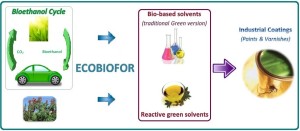
The European Union annually uses 5 million tons of solvents, while 0.63 million tons of these are ‘bio-based’. Even though the bulk of solvents used in the market belong to paint, ink and adhesive industies (about 58 percent), only 1.5 percent are allocated in the category ‘bio’. Sustainability is a highlighted issue in the paint and ink industry, however to create a more sustainable product it is essential to have a sustainable solvent. The sector requires greener processes and components for coatings, inks, adhesives, paint and varnishes. The solvents are the basic and most necessary component in processing and composition. The development of these bio solvents are a clear example of the potential for the application of biotechnology and green chemistry at an industrial level, generating patentable and economically viable technical results in the form of new products and technologies.
A new generation of more sustainable paints
The project ECOBIOFOR aims to develop novel bio-based solvents using ‘greener’ chemical and biotech transformation processes. It fundamentally focuses on two important objectives: One is the replacement of petrochemical solvents with renewable vegetable alternatives which have the same composition and similar properties. The principles of green chemistry are carefully applied to chemical products and processes taking into account aspects such as the entire life cycle of the chemical compound, its design, production and use. Even though the carbon footprint is reduced when compared to the petrochemical solvents, there are still remains of the volatile organic compounds. Also these solvents have an advantage of being offered at a constant market price consistently since they are less sensitive to fluctuations in oil prices. Another objective is the development of reactive solvents which mix totally with the paint film without becoming a residue. These reactive organic solvents have an advantage that they emit no volatile organic compounds.
In order to achieve the objectives of the ECOBIOFOR project, a multidisciplinary and complementary consortium has been built consisting of eleven organisations from six different countries. The consortium comprises the whole supply chain, from the raw materials provider to the end-users. In dividing responsibilities and tasks among partners, an effort has been made to draw upon the relative strengths of each partner and to encourage active collaboration among the various SMEs and other enterprises and end-users.
This post is based on a text provided by Idoia Etxeberria, PhD.; ECOBIOFOR project coordinator, FUNDACIÓN TECNALIA RESEARCH & INNOVATION, Spain.
For more details on the project, please visit www.ecobiofor.eu



